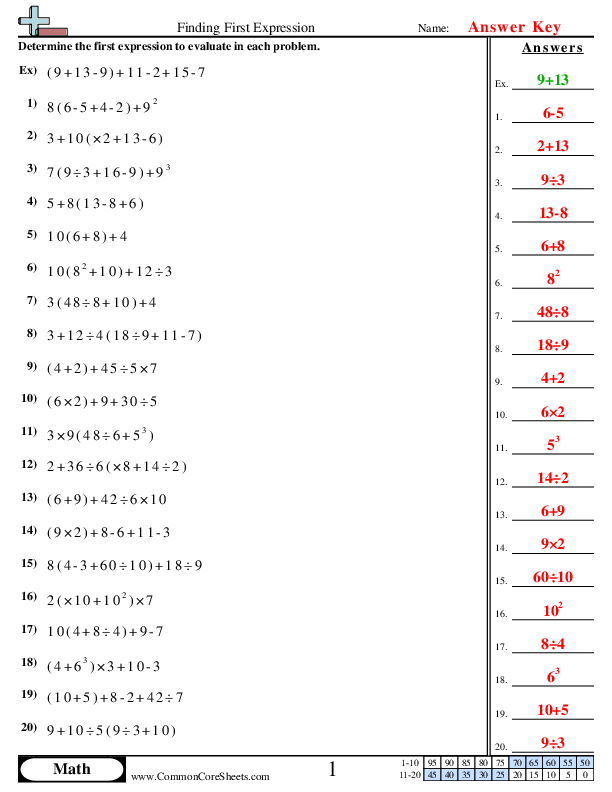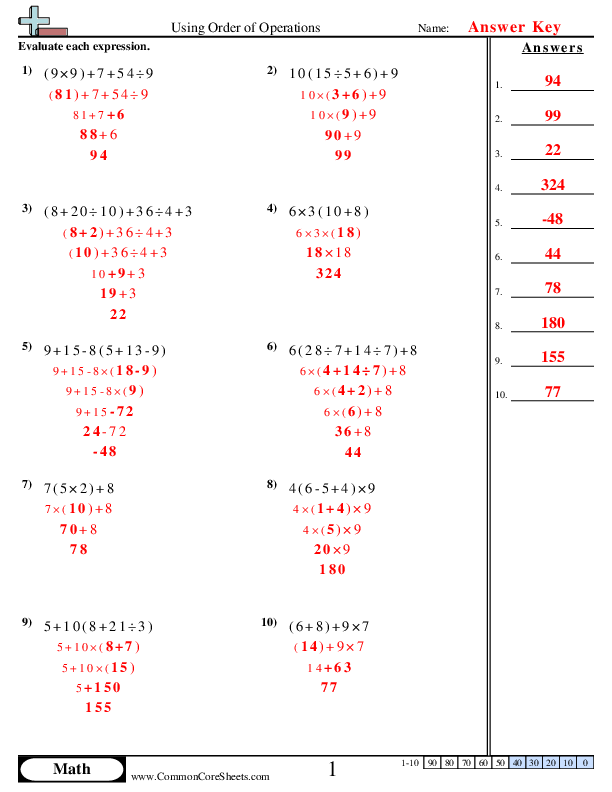Order of operations worksheets are a crucial resource for students learning about PEDMAS (Parentheses, Exponents, Division, Multiplication, Addition, Subtraction). These worksheets provide practice with solving mathematical expressions using the correct order of operations. Our order of operations worksheets are the best on the internet and are available for free to help students succeed in math. With a variety of exercises and levels of difficulty, our order of operations worksheets are perfect for students of all ages. So why wait? Get the best order of operations worksheets on the internet for free and start mastering PEDMAS today!
Browse Sheets By Problem Type
×
Solving Order of Operations
Link

Finding First Expression
6ee2c


×
Description:
"This worksheet is designed to reinforce children's basic math skills, focusing on the concept of finding the first expression through 20 unique problems. It's highly flexible and can be customized, transformed into interactive flashcards, or incorporated into distance learning programs, creating a multifaceted approach to mathematics instruction. A must-have resource for effective learning."

×
Student Goals:
Develop Mathematical SkillsUpon completion of the worksheet, students are expected to have honed their calculation skills. They will learn to apply basic math operations like addition, subtraction, multiplication, and division correctly and swiftly. It will also help develop their understanding of the order of operations in math problems and enable them to solve complex mathematical problems independently.Enhance Problem Solving AbilitiesThe worksheet is designed to challenge students to think critically and logically, thereby enhancing their problem-solving abilities. Through solving the 20 problems in the worksheet, students will be able to approach mathematical puzzles systematically. They will learn to break down complex problems into simple, manageable steps, enhancing their confidence in tackling mathematical challenges.Promote Analytical ThinkingThe problems in the worksheet are geared towards promoting students' analytical thinking skills. They will learn to analyze each math expression carefully, which will strengthen their understanding of math concepts as a whole. It allows them to visualize arithmetic as not just rote calculations, but as set of logical steps. Through the repeated practice, students will begin to recognize patterns in math expressions, which can strengthen their analytical skills.Improve Precision and AccuracyThis worksheet helps students to improve their precision and accuracy during mathematical computations. They become progressively adept at handling numbers and operations and can avoid common mathematical errors. Each correct answer provides positive reinforcement, increasing their competence in the subject.Increase Patience and PerseveranceCompleting the worksheet is expected to build students' patience and perseverance. As the problems become increasingly complex, students are needed to spend more time and thought in solving the problems. By working through these challenges, they will learn the importance of persistence in problem-solving activities. Even if they don't get the right answer the first time, they're encouraged to try again, instilling in them an understanding and acceptance of trial and error in learning.Boosts Confidence in MathematicsBy successfully completing and understanding the worksheet, students gain confidence in their mathematical abilities. This increased confidence can motivate students to participate more actively in class and take on more complex problems. Moreover, the confidence gained can also contribute to the positive attitude towards mathematics and academic achievement in general.



Using Order of Operations (No Negatives)


×
Description:
"This worksheet is designed to enhance children's understanding of the order of operations in mathematics. Featuring 10 customizable problems encompassing concepts like the BODMAS rule, students learn to deal with complex calculations involving addition, subtraction, division, and multiplication. The content can be converted into flashcards for effective study or leveraged for distance learning, adapting to versatile teaching methods and learning styles."

×
Student Goals:
Improved Mathematical SkillsUpon successful completion of the worksheet, students should demonstrate considerable mastery of the order of operations in mathematics. This fundamental mathematical concept will enable them to solve increasingly complex arithmetic equations accurately.Enhanced Logical ReasoningBy navigating through the tasks in the worksheet, students are expected to enhance their logical reasoning capabilities. The process of identifying the correct sequence of operations to apply in each problem facilitates the development of logical thought processes and critical thinking.Improved Problem SolvingAfter working on the worksheet, students should be able to better evaluate and solve problems. This inherent skill extends beyond math and into everyday life where solutions often require sequential steps or operations.Increased Confidence in MathematicsSuccessfully completing the problems set in the worksheet should give students increased confidence in tackling math problems, especially those involving order of operations. Confidence is key to nurturing a positive attitude towards mathematics, reducing math anxiety and fostering a growth mindset.Preparing for Advanced Math ConceptsMastering the order of operations is fundamental to understanding more advanced mathematical concepts. Upon finishing this worksheet, students should be well prepared to tackle higher-level mathematical equations and problems that require an in-depth understanding of the principles of operations and their hierarchical execution.Enhanced Mathematical FluencyArriving at correct solutions to the presented problems should signify that students are becoming more fluent in their math skills. Mathematical fluency entails precision, accuracy, and speed in solving math problems, and this worksheet is designed to foster such fluency.Comprehension of Mathematical SyntaxStudents will demonstrate that they have a grasp of the syntax of arithmetic. Understanding this syntax, as signified by the correct use and interpretation of parentheses, brackets and operation signs, is central to successfully encoding and decoding mathematical phrases and sentences.




